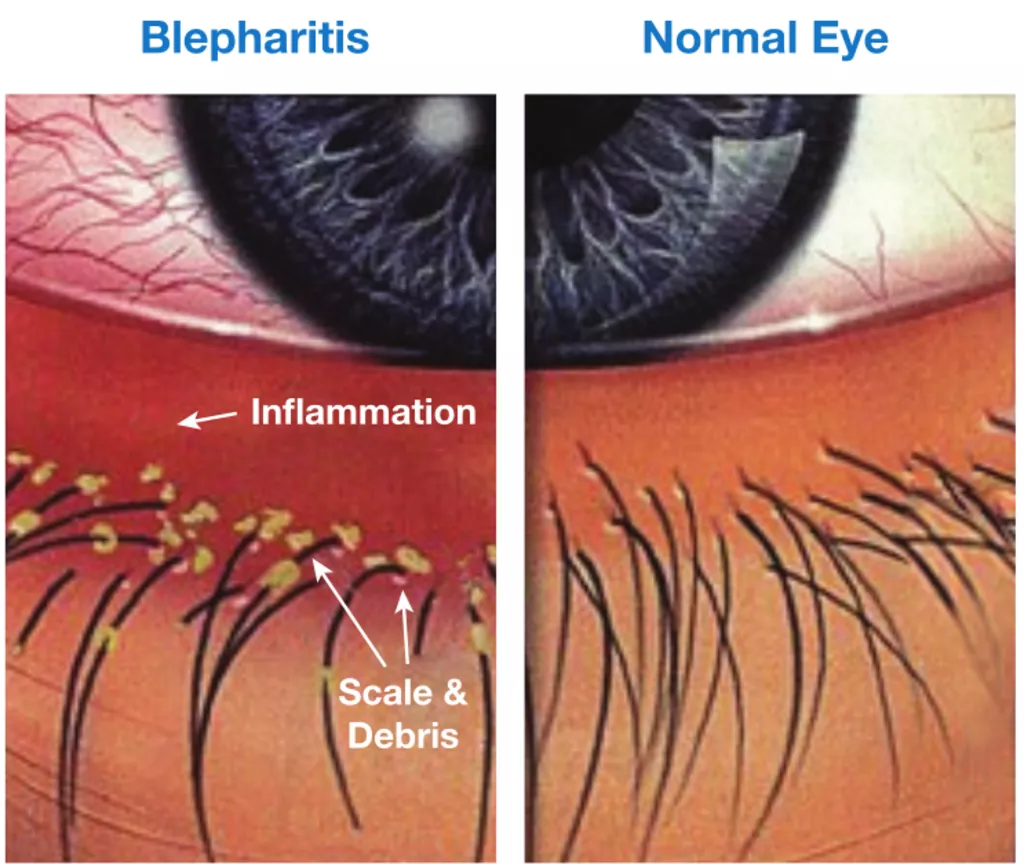What is blepharitis?
Blepharitis is a common chronic condition of the eyelids, characterized by persistent inflammation of the lid margins.
It is often classified into two types:
Anterior blepharitis mainly affects the outer front edge of the eyelid margin, where the eyelashes grow. It often causes scales around the eyelashes and an overgrowth of bacteria, which produce toxins that irritate the eye.
Posterior blepharitis (meibomian gland dysfunction, MGD) mainly affects the inner back edge of the eyelid margin, which is in contact with the eye. The meibomian oil glands, located in a row behind the eyelashes, become blocked with thickened waxy oil. This leads to drying of the tears on the surface of the eye because they lack their normal healthy oil coating. It also causes an overgrowth of bacteria, which produce toxins that irritate the eye.

Who gets blepharitis?
Blepharitis is a common condition that can occur in anyone, at any age. It is most common in people with oily skin or rosacea.
What are the
main symptoms of blepharitis?
Blepharitis
may cause irritation, burning, itching and the sensation of something
in the eye. The eyes often become red and watery, but may feel dry.
The vision may be variable. The eyelids may appear red-rimmed and
there may be crusts in the eyelashes or cysts near the eyelid
margins.
Is blepharitis
serious?
In most cases blepharitis
is annoying but does not cause serious harm to the eye. However,
complications of blepharitis may develop, including meibomian cysts,
ingrown eyelashes, dry eye and corneal ulcers.
What
treatments can help with blepharitis?
There
is no simple cure for blepharitis and controlling it often involves a
combination of several different treatments:
Eyelid hygiene should be done twice daily for the first few weeks, and then may be reduced to once daily once the blepharitis has improved. There are three components:
- Hot compresses – this softens the oil in the meibomian glands and loosens any crusts around the eyelashes. Ideally, use a small wheat bag, which is heated in the microwave for about 30 seconds, then place over the eyes for 5-10 minutes. This retains its warmth much longer than a damp cloth.
- Eyelid massage – after the hot compress, use the tips of your fingers to massage the eyelids, along the whole length of the upper and lower lids. This is useful in posterior blepharitis to help squeeze the oil out of the clogged meibomian glands.
- Lid scrubs – using warm water and either a facecloth of a cotton bud, scrub gently along the rims of the eyelid, close to the eyelashes. A few drops of baby shampoo may be added to the water. Alternatively a commercial product such as ‘Lid Care’ wipes, or ‘Sterilid’ foam may be used. Lid scrubs are particularly useful in anterior blepharitis, to remove any scales from around the eyelashes.
Tear supplements often help relieve some of the symptoms of blepharitis by replacing the natural tears, which may be evaporating too fast, and by diluting any toxic chemical in the tears. There are numerous different artificial tear drops, which are available without prescription at pharmacies. Most of these drops can be used safely up to four times daily. Should these artificial tear drops be required more frequently, then preservative free ones are recommended.
Antibiotic ointment may be prescribed for a period of time. It can be applied with a clean fingertip or a cotton bud to the eyelid margins or applied directly into the eye. This helps to reduce the buildup of bacteria in the oil glands and around the eyelashes, which often contribute to the inflammation caused by blepharitis.
Steroid eyedrops may occasionally be prescribed for a short course. They are anti-inflammatory, which reduce the redness, swelling and discomfort caused by blepharitis. If steroid drops are used you will be monitored by your Eye Doctor for potential side effects, such as glaucoma, cataracts and infections.
Oral antibiotics, such as Doxycycline or Azithromycin may be prescribed for more persistent blepharitis. A low dose is normally used and sometimes for a long course. Although generally well-tolerated, potential side effects include sun-sensitivity and abdominal upsets can occasionally occur.
Omega 3 supplements, such as fish or flax seed oil, are widely available over the counter. These may be beneficial in blepharitis with long term use. They have anti-inflammatory properties and may also improve the quality of the oil component of the tears.
A range of additional treatments may be available for resistant blepharitis, including Intense Pulsed Light (IPL) and Lipiflow. Your Eye Doctor can advise you if these are suitable for you.

